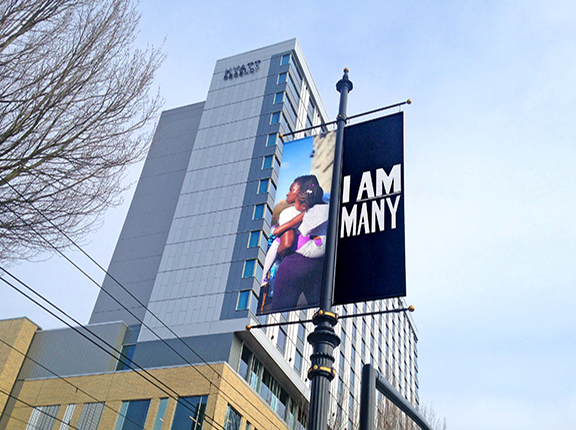We remain committed to our clients and business continuity as we work remotely. We are focused on delivering services with the dependability and quality that you’ve come to expect from Mayer/Reed while we protect the health of our community.
Online Open House – SW Corridor Light Rail
We’ve reached a major milestone in the design of the Southwest Corridor Light Rail Project with the release of the draft Conceptual Design Report, 14 months in the making. The proposed 11-mile extension of the MAX light rail system will connect Downtown Portland, Southwest Portland, Tigard and Tualatin.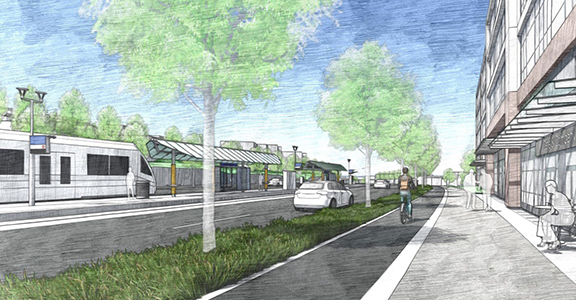 Leading the conceptual design, a joint venture between Mayer/Reed, ZGF and VIA Architecture prepared an overview of the corridor context and history and developed proposed urban design concepts including biking and walking improvements, stormwater strategies, station configurations, structures, streetscape and system elements summarized in the report. Special strategies such as tunnels, flyovers, elevators and even an inclined elevator – a modern type of funicular – are proposed to respond to the more challenging site conditions along the route.
Leading the conceptual design, a joint venture between Mayer/Reed, ZGF and VIA Architecture prepared an overview of the corridor context and history and developed proposed urban design concepts including biking and walking improvements, stormwater strategies, station configurations, structures, streetscape and system elements summarized in the report. Special strategies such as tunnels, flyovers, elevators and even an inclined elevator – a modern type of funicular – are proposed to respond to the more challenging site conditions along the route.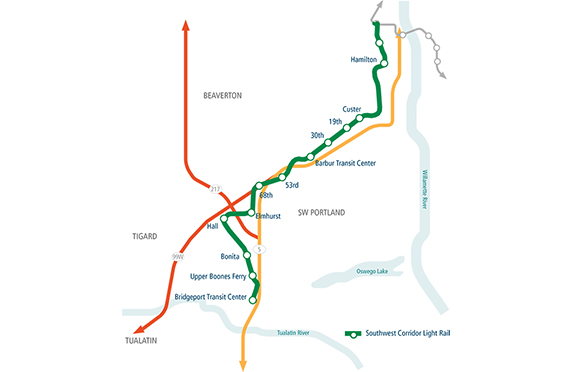 Throughout the process we’ve enjoyed interacting with the communities along the line. A recent series of open houses shared the concepts and collected community input which the team will use to finalize the report in anticipation of a funding bond measure. There’s still time contribute your thoughts until March 27 through TriMet’s online open house.
Throughout the process we’ve enjoyed interacting with the communities along the line. A recent series of open houses shared the concepts and collected community input which the team will use to finalize the report in anticipation of a funding bond measure. There’s still time contribute your thoughts until March 27 through TriMet’s online open house.
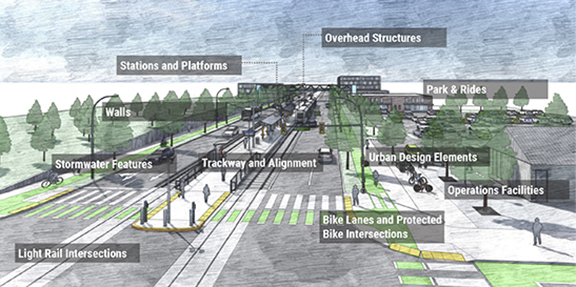
Another Brilliant Portland Winter Light Festival
For the 5th year in a row, dazzling, illuminated installations and performances delighted festival-goers during the Portland Winter Light Festival held February 6-8th.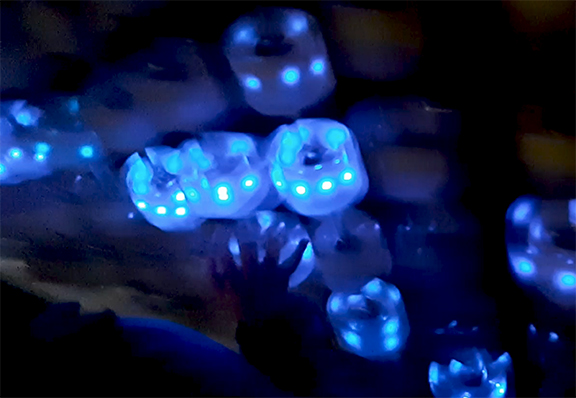 As darkness approached on opening night, a crew from Mayer/Reed walked from our downtown studio to partake in the festivities flanking the riverfront. Such amazing displays! Our first stop, of course, was the installation we designed – Kinetic DeLight. We had so much fun watching the night light up as people found their own, unique ways of interacting with the hundreds of human-powered LED skateboard wheels. Mayer/Reed is proud to have supported this community-building event since the beginning – as sponsors, designers and volunteers – and we look forward to next year’s bright ideas.
As darkness approached on opening night, a crew from Mayer/Reed walked from our downtown studio to partake in the festivities flanking the riverfront. Such amazing displays! Our first stop, of course, was the installation we designed – Kinetic DeLight. We had so much fun watching the night light up as people found their own, unique ways of interacting with the hundreds of human-powered LED skateboard wheels. Mayer/Reed is proud to have supported this community-building event since the beginning – as sponsors, designers and volunteers – and we look forward to next year’s bright ideas.
In-Between
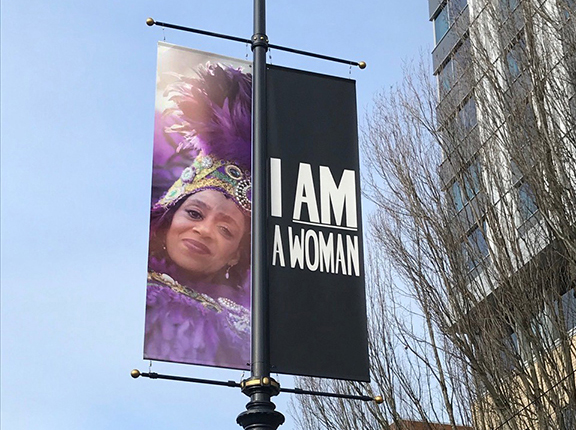
Look up! It’s new public art along NE Holladay Street. Titled “In-Between,” the banners are part of Portland’s Percent For Art program made possible by the new Oregon Convention Center parking structure. With text by Brooklyn-born artist, Hank Willis Thomas, and photographs by local artist, Intisar Abioto, the artwork transforms five utility poles in the street median to hold ten large banners, displayed in pairs. The exhibit kicks off an on-going art banner series that will be refreshed every six months with new works by different artists.
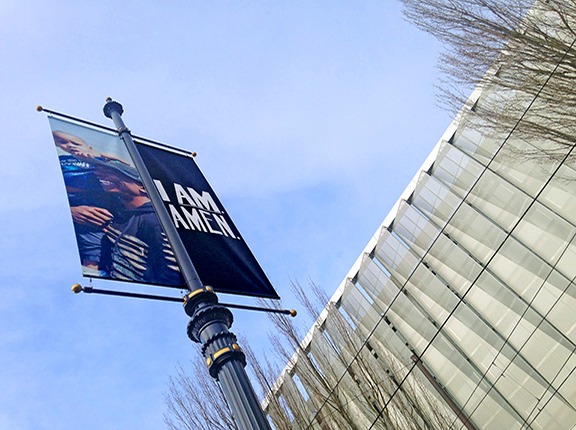
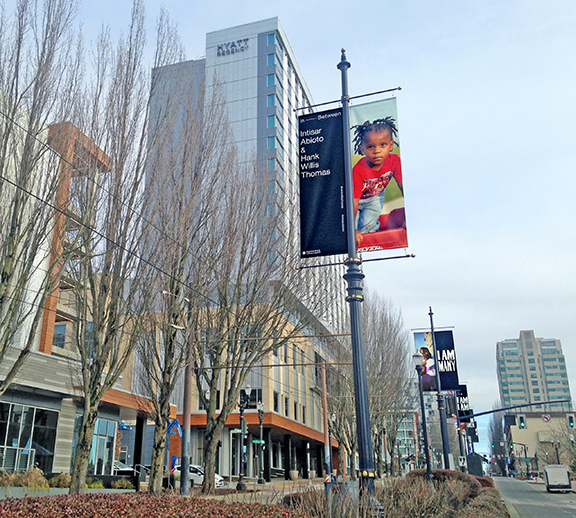
As the lead urban designer for the parking garage, it was such a rewarding experience to serve on the art selection committee with partners from the neighborhood, local artists, Portland Art Museum, Prosper Portland and Metro. Many thanks to Peggy Kendellen at the Regional Arts and Culture Council (RACC) for her vision and guidance throughout this process in the spirit of innovation. Through the synthesis of team brainstorming our committee discovered a path forward by questioning, “Who are we, how did we get here and where are we going?” all while dealing with a very visible, complex, and congested urban site. We have deep appreciation for both artists – Intisar Abioto and Hank Willis Thomas – for their melding of talents, curatorship of their combined works and synergy to bring this work to fruition. It’s not often we find a single installation speaking in such a clear voice to convey collaboration, respect, historic truth telling and beauty.